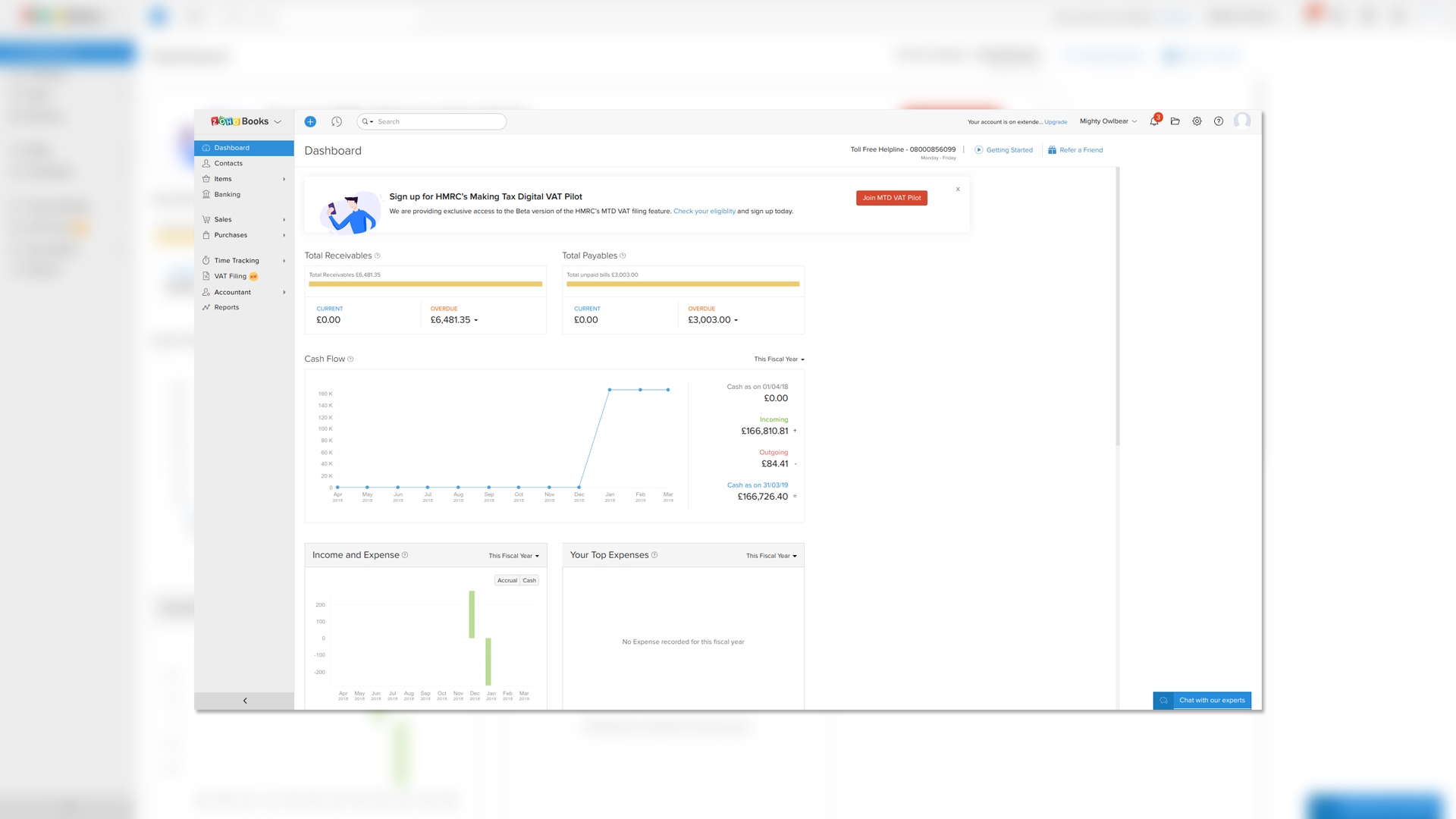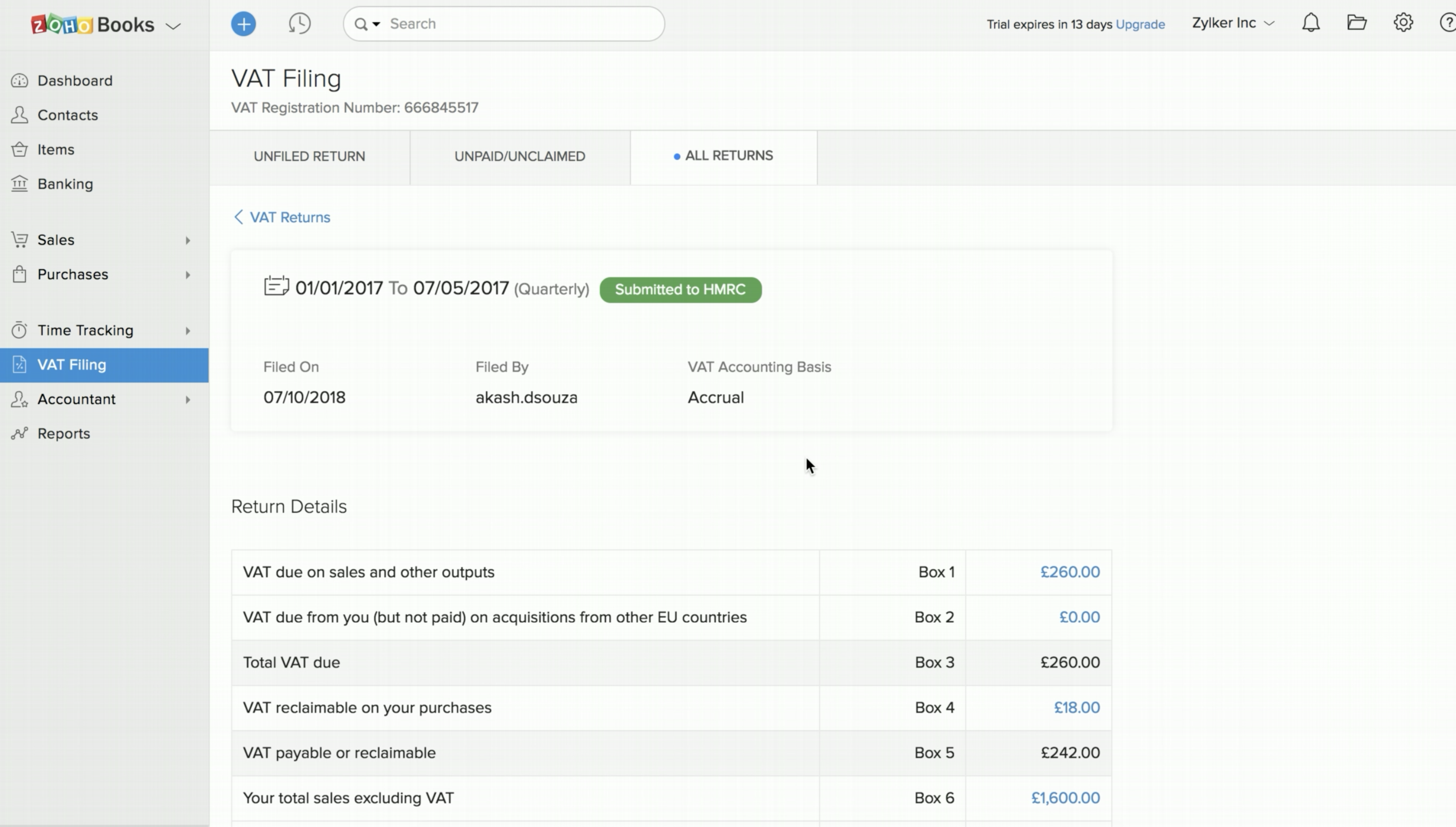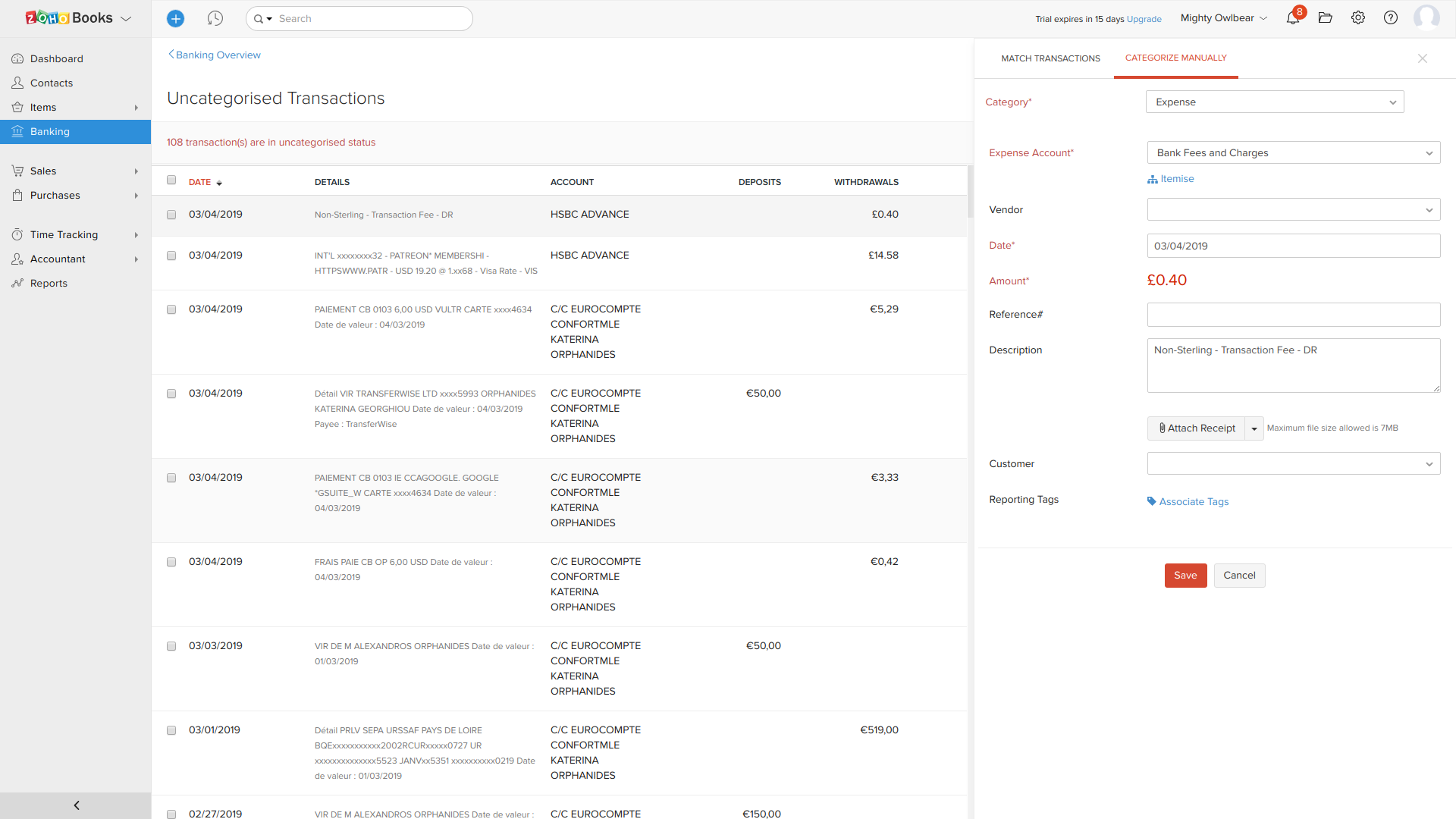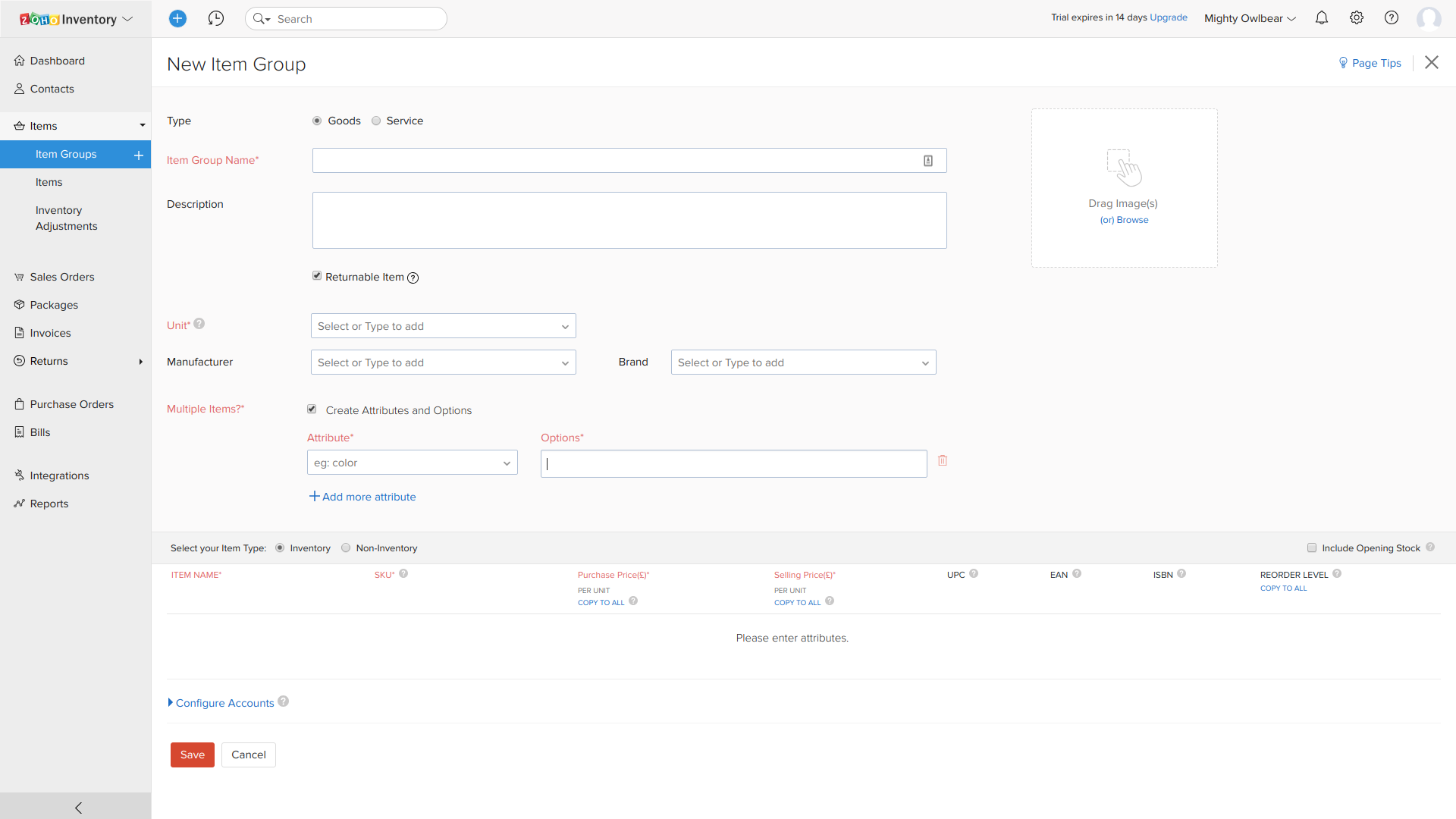Zoho Books review: Everything but the kitchen sink
A relatively low-cost accounting suite with a huge range of features at all tiers, but lacking integrated payroll


Although it can't handle your payroll, Zoho Books is very capable at all price tiers and has an outstanding mobile app, making it a cost-effective choice for small businesses with worldwide customers. It's not easy to use as QuickBooks, but if you don't mind handling your payroll elsewhere, it's a great budget buy.
-
+
Comparatively inexpensive; Feature-packed
-
-
No payroll

Indian Software-as-a-Service giant Zoho is among the cloud-based accounting software firms working with HMRC to ensure that VAT registered companies are all set to use the new Making Tax Digital reporting process from the beginning of April 2019.
Zoho has European data centres in Dublin and the Netherlands, as well as the US, so doesn't have to rely on the sometimes controversial EU-US Privacy Shield data protection framework. Zoho's European data centres are covered by the UK's decision to regard all EEA member states as meeting adequate data protection requirements, even in the case of a no-deal Brexit.
Priced in dollars, no matter where you are in the world, Zoho Books is a very competitive option across its subscription tiers. There are three, scaled to fit micro, small and medium businesses respectively.
Priced at $9 (6.83), Zoho Books Basic supports one user, with an extra account for inviting your accountant, with up to 50 contacts and five automated workflows. Workflows allow you to automate some features, for example sending email instructions to the relevant shipping and packing department when a sale is made, automatically applying discounts to large orders, or webhooks to send text messages to clients or suppliers when bills are paid.
It has a standard but useful set of core features: bank reconciliation, custom invoices, expense tracking, projects and timesheets which are rare to find in entry-level accounting suites - plus recurring transactions and sale approval so staff sales can be double-checked if needed.

For $19 (14.42), you get Zoho Books Standard, with support for 500 contacts, two users plus your accountant, and 10 automated workflows or modules. Extra features include the ability to log bills, issue vendor credits, use reporting tags, require purchase approval and receive SMS notifications.
The top Professional tier, which costs $29 (22.02), has unlimited contacts,10 user seats, purchase and sales orders, an inventory for basic stock control and support for a custom domain name.
Unusually, all three support multiple currencies. You can also connect a variety of other Zoho cloud-based business tools for project management, analytics, CRM and more.
Zoho Books review: Setup and configuration
Once you've signed up for Zoho Books, you're prompted to give your client portal a unique name, set your opening balances, edit the default Chart of Accounts or import your own, configure direct feed links to your bank accounts and invite staff and your accountant to access your books. This simple to-do list is clearly described and helps you transition your accounts into Zoho with a minimum of fuss.
Zoho has a particularly detailed set of fields for opening balances, which allow you to track specific expenses, assets, liabilities and equity, as well as the overall status of your accounts receivable and payable.
If you have a lot of invoices due when you set your starting balances, Zoho warns you that your total debits and credits don't balance this isn't actually a problem for the software, although the exclamation-mark emblazoned alert pop-up makes it look like one. It is important to make sure that your opening balances are correct, though, and Zoho helpfully takes you through a confirmation screen to ensure this, while providing information on how to correct any errors in future.
Similarly, we appreciated being prompted to check over Zoho's default Chart of Accounts. It's simple by design, with just a few standard categories common to every business, but it's easy to add more for example, you may wish to create separate entries for the sale of goods and sale of services.
The final suggestions direct you to set up a bank feed and give others access to your accounts if they need it, and there's where the Getting Started section leaves you to it. Users new to cloud-based accounting software would probably welcome a bit more hand-holding when it comes to configuring features like invoices, bills and time tracking for projects.
Zoho Books review: Banking
Like most cloud-based accounting suites, Zoho Books can link directly to your online banking service to import transactions. This worked smoothly, although to complete some bank connection we had to search for our bank, sign in, and then search again to be taken to a screen that allowed us to choose which of our accounts we wished to connect.
A wide range of British high street, business and international banks are supported, as well as PayPal. However, support for recent digital challenger banks is very thin on the ground, with no sign of TransferWise, Shine, ING or Revolut, among others.
Fortunately, it's very easy to add banks and upload statements manually, whether that's because your bank isn't featured or because you simply prefer not to give your accounting suite read access to your bank accounts.

Just select Add bank or credit card from the Banking screen, then hit the big blue Enter your account manually' button. You'll be prompted to give the account a name, select its currency and details such as account number or IBAN. You're then prompted to upload a statement in CSV, TSV, OFX, QIF or CAMT.053 format.
With that done, you can reconcile your transactions, assigning them to clients, suppliers and expenses and matching them against bills and invoices once you've created them. Small and micro business owners, in particular, will appreciate clearly defined categories for drawings, which not all accounting suits make so visible.
Zoho Books review: Invoicing, customers and bills
Although it's not highlighted in the getting started guide to the extent that we'd expect, it's hard to fault Zoho's invoicing workflow. When you create an invoice for the first time, you're asked to configure how you handle discounts. When you set an invoice number, a pop-up immediately asks you how you'd like to handle future invoice numbering for example by continuing from a specific number.
And when you enter a customer name, a window pops up so you can add them as a contact, including details on the currency and payment terms for the specific customer. There are fields for their social media details, and you can even enable an online portal that customers can use to access and pay their invoices. A wide range of online payment providers, including PayPal, Stripe and Worldpay, are supported.
You can save invoices as drafts, although they'll have to have at least one named item in them before you can do so. Quick invoice creation, along with fast add options for customers, vendors, bills, expenses, inventory, owner drawings and more, is instantly available via a small blue plus button at the top of the screen.
Bills and expenses work in much the same way, complete with support for attached images of receipts, and there are sample CSV and XLS forms to help you bulk upload invoice and bill data, which is helpful if you're moving across from another accounting suite.
Zoho Books review: VAT returns and other tax support
Zoho Books fully supports HMRC's electronic Making Tax Digital system, and also provides tools for tracking VAT MOSS for European sales.
For MTD, you're taken through the process of connecting your HMRC account, after which a VAT Filing module will be available in the main left-hand navigation bar. From there, you'll be able to generate VAT returns at the click of a button, check them over, make any necessary adjustments and submit them to HMRC.
Unfortunately, payroll support and all related tax and deduction handling is conspicuous by its absence. Zoho Payroll isn't currently available outside the US and while the company is looking into integration with third-party payroll services, it can't specify when this feature will be available. For now, you'll have to use another service to handle payslips, PAYE and pensions and simply log those outgoings in Zoho Books.
Zoho Books review: Inventory, time tracking and integrations
Zoho Books is packed with features and also integrates with other Zoho cloud-based business tools, such as Expense, Subscriptions, Inventory and Checkout and CRM, plus document autoscanning that can automatically transcribe 50 items of paperwork a month. However, these cost extra.
But plenty more is built into the standard subscription and ready to go. For Professional subscribers, the Zoho Books Items tool can handle complex, illustrated price lists and inventory tracking, providing simple and effective stock management for sales-oriented businesses. Using its Time Tracking tools, available at all tiers, you can bill by staff, project or task hours and add multiple Zoho Books users to projects in order to track their time.

This is made easy by the Zoho Books mobile apps which, as well as real-time and post-dated time logging for users, provide handy shortcuts for adding expenses, invoices and contacts on the move, and a near-complete replica of the desktop browser features, from banking and reconciliation to reports, with the exception of VAT filing.
Zoho Books review: Interface
Zoho Books looks nice, is easy to read and presents all its information clearly, but it lacks the generous guidance and help of many other online accounting suites. We found that it took a little longer to learn our way around than in rival products from Xero, Sage and Quickbooks.
Its sidebar behaviour is also sometimes inconsistent. Click on Dashboard, Contacts, Banking or Reports, and a new screen opens with options or data to view. However, the Items, Sales, Purchases, Time Tracking and Accountant tabs all open up further sub-menus rather than an overview screen.
Fortunately, once you've learned the ropes, everything becomes second nature, even though we'd have appreciated an integrated help interface rather than being redirected to a separate support portal to search for answers.
Zoho Books review: Verdict
Zoho Books provides an excellent set of tools for managing your business's incomings, outgoings and VAT. Its top tier is great for sales-oriented businesses that need inventory tracking. Small businesses with international clients will be pleased to note that multicurrency support, time tracking and integrated VAT returns are supported at all tiers. The only major downside is that it doesn't have any kind of payroll facility.
However, a wealth of features at even lower subscription tiers, along with the current strength of the pound relative to Zoho's US dollar pricing, makes this a very worthwhile choice for a small business on a budget, particularly if you already use an external payroll service.
Verdict
Although it can't handle your payroll, Zoho Books is very capable at all price tiers and has an outstanding mobile app, making it a cost-effective choice for small businesses with worldwide customers. It's not easy to use as QuickBooks, but if you don't mind handling your payroll elsewhere, it's a great budget buy.
Get the ITPro daily newsletter
Sign up today and you will receive a free copy of our Future Focus 2025 report - the leading guidance on AI, cybersecurity and other IT challenges as per 700+ senior executives
K.G. is a journalist, technical writer, developer and software preservationist. Alongside the accumulated experience of over 20 years spent working with Linux and other free/libre/open source software, their areas of special interest include IT security, anti-malware and antivirus, VPNs, identity and password management, SaaS infrastructure and its alternatives.
You can get in touch with K.G. via email at reviews@kgorphanides.com.
-
 ‘Phishing kits are a force multiplier': Cheap cyber crime kits can be bought on the dark web for less than $25 – and experts warn it’s lowering the barrier of entry for amateur hackers
‘Phishing kits are a force multiplier': Cheap cyber crime kits can be bought on the dark web for less than $25 – and experts warn it’s lowering the barrier of entry for amateur hackersNews Research from NordVPN shows phishing kits are now widely available on the dark web and via messaging apps like Telegram, and are often selling for less than $25.
By Emma Woollacott Published
-
 Redis unveils new tools for developers working on AI applications
Redis unveils new tools for developers working on AI applicationsNews Redis has announced new tools aimed at making it easier for AI developers to build applications and optimize large language model (LLM) outputs.
By Ross Kelly Published
-
 Google layoffs continue with "hundreds" cut from Chrome, Android, and Pixel teams
Google layoffs continue with "hundreds" cut from Chrome, Android, and Pixel teamsNews The tech giant's efficiency drive enters a third year with devices teams the latest target
By Bobby Hellard Published